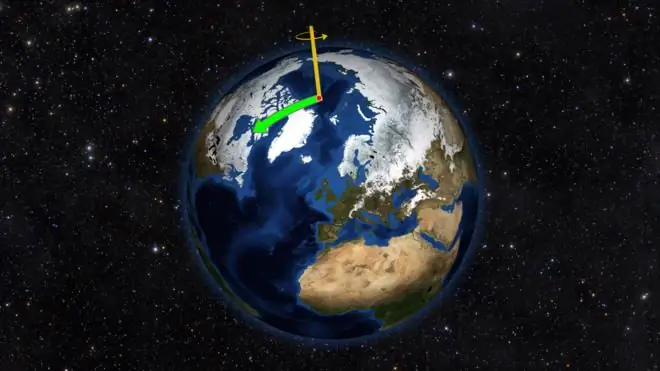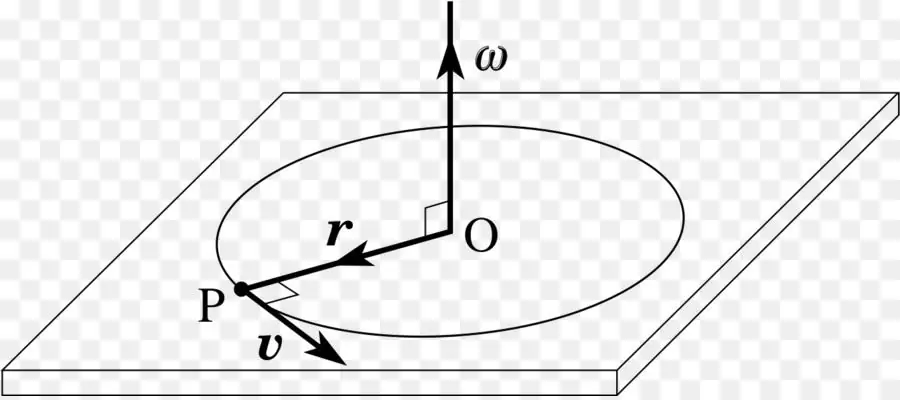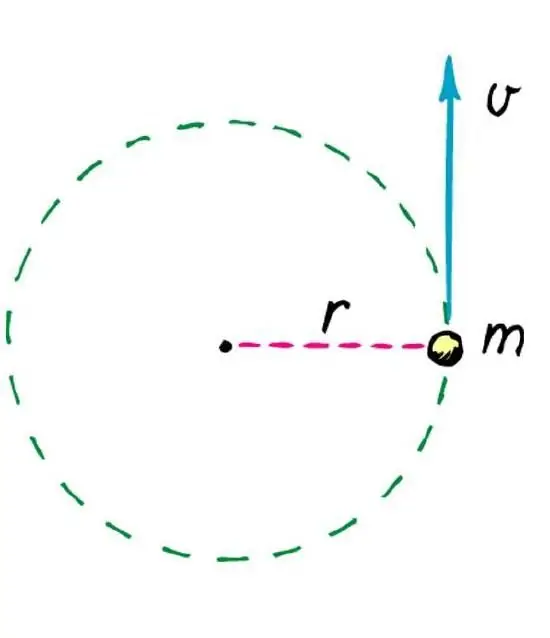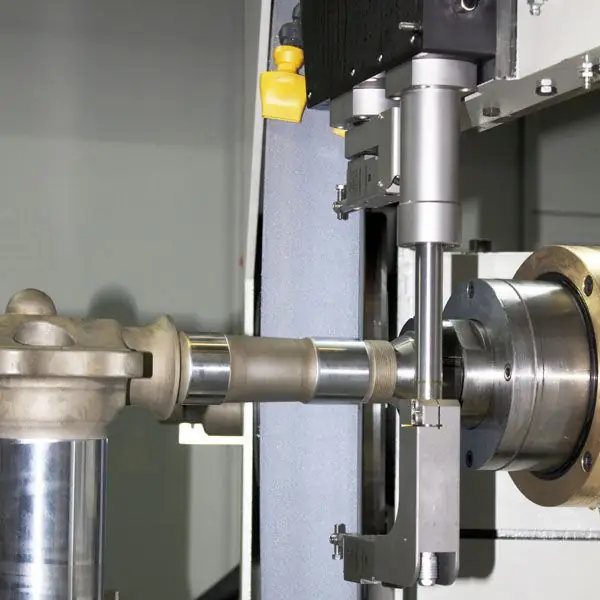In nature and technology, we often encounter the manifestation of the rotational motion of solid bodies, such as shafts and gears. How this type of motion is described in physics, what formulas and equations are used for this, these and other issues are covered in this article.
What is rotation?
Each of us intuitively imagines what kind of movement we are talking about. Rotation is a process in which a body or material point moves along a circular path around some axis. From a geometric point of view, the axis of rotation of a rigid body is a straight line, the distance to which remains unchanged during the movement. This distance is called the radius of rotation. In what follows, we will denote it by the letter r. If the axis of rotation passes through the center of mass of the body, then it is called its own axis. An example of rotation around its own axis is the corresponding movement of the planets of the solar system.

For rotation to occur, there must be centripetal acceleration, which occurs due tocentripetal force. This force is directed from the center of mass of the body to the axis of rotation. The nature of the centripetal force can be very different. So, on a cosmic scale, gravity plays its role, if the body is fixed by a thread, then the tension force of the latter will be centripetal. When a body rotates around its own axis, the role of the centripetal force is played by the internal electrochemical interaction between the elements (molecules, atoms) that make up the body.
It must be understood that without the presence of a centripetal force, the body will move in a straight line.
Physical quantities describing rotation

First, it's dynamic characteristics. These include:
- momentum L;
- moment of inertia I;
- moment of force M.
Secondly, these are the kinematic characteristics. Let's list them:
- rotation angle θ;
- angular speed ω;
- angular acceleration α.
Let's briefly describe each of these quantities.
The angular momentum is determined by the formula:
L=pr=mvr
Where p is the linear momentum, m is the mass of the material point, v is its linear velocity.
The moment of inertia of a material point is calculated using the expression:
I=mr2
For any body of complex shape, the value of I is calculated as the integral sum of the moments of inertia of material points.
The moment of force M is calculated as follows:
M=Fd
Here F -external force, d - distance from the point of its application to the axis of rotation.
The physical meaning of all quantities, in the name of which there is the word "moment", is similar to the meaning of the corresponding linear quantities. For example, the moment of force shows the ability of an applied force to impart angular acceleration to a system of rotating bodies.
Kinematic characteristics are mathematically defined by the following formulas:
ω=dθ/dt;
α=dω/dt.
As you can see from these expressions, the angular characteristics are similar in meaning to linear ones (velocity v and acceleration a), only they are applicable to a circular trajectory.
Rotation dynamics
In physics, the study of the rotational motion of a rigid body is carried out with the help of two branches of mechanics: dynamics and kinematics. Let's start with dynamics.
Dynamics studies external forces acting on a system of rotating bodies. We will immediately write down the equation of rotational motion of a rigid body, and then, we will analyze its constituent parts. So this equation looks like:
M=Iα
The moment of force, which acts on a system with moment of inertia I, causes the appearance of angular acceleration α. The smaller the value of I, the easier it is with the help of a certain moment M to spin the system up to high speeds in short time intervals. For example, a metal rod is easier to rotate along its axis than perpendicular to it. However, the same rod is easier to rotate about an axis perpendicular to it and passing through the center of mass than through its end.
Conservation lawvalues L
This value was introduced above, it is called the angular momentum. The equation of rotational motion of a rigid body, presented in the previous paragraph, is often written in a different form:
Mdt=dL
If the moment of external forces M acts on the system during the time dt, then it causes a change in the angular momentum of the system by dL. Accordingly, if the moment of forces is equal to zero, then L=const. This is the law of conservation of the value L. For it, using the relationship between linear and angular velocity, we can write:
L=mvr=mωr2=Iω.
Thus, in the absence of the moment of forces, the product of the angular velocity and the moment of inertia is a constant value. This physical law is used by figure skaters in their performances or artificial satellites that need to be rotated around their own axis in outer space.

Centripetal acceleration
Above, when studying the rotational motion of a rigid body, this quantity has already been described. The nature of the centripetal forces was also noted. Here we will only supplement this information and give the corresponding formulas for calculating this acceleration. Denote it ac.
Since the centripetal force is directed perpendicular to the axis and passes through it, it does not create a moment. That is, this force has absolutely no effect on the kinematic characteristics of rotation. However, it creates a centripetal acceleration. We give two formulas forits definitions:
ac=v2/r;
ac=ω2r.
Thus, the greater the angular velocity and radius, the greater the force must be applied to keep the body on a circular path. A striking example of this physical process is the skidding of a car during a turn. A skid occurs when the centripetal force, which is played by the friction force, becomes less than the centrifugal force (inertial characteristic).

Rotation kinematics
Three main kinematic characteristics were listed above in the article. The kinematics of the rotational motion of a rigid body is described by the following formulas:
θ=ωt=>ω=const., α=0;
θ=ω0t + αt2/2=> ω=ω0 + αt, α=const.
The first line contains formulas for uniform rotation, which implies the absence of an external moment of forces acting on the system. The second line contains formulas for uniformly accelerated motion in a circle.

Note that rotation can occur not only with positive acceleration, but also with negative one. In this case, in the formulas of the second line, put a minus sign before the second term.
Example of problem solving
A moment of force of 1000 Nm acted on the metal shaft for 10 seconds. Knowing that the moment of inertia of the shaft is 50kgm2, it is necessary to determine the angular velocity that the said moment of force gave to the shaft.

Applying the basic equation of rotation, we calculate the acceleration of the shaft:
M=Iα=>
α=M/I.
Since this angular acceleration acted on the shaft during the time t=10 seconds, we use the uniformly accelerated motion formula to calculate the angular velocity:
ω=ω0+ αt=M/It.
Here ω0=0 (the shaft did not rotate before the moment of force M).
We substitute the numerical values of the quantities into equality, we get:
ω=1000/5010=200 rad/s.
To convert this number into the usual revolutions per second, you need to divide it by 2pi. After completing this action, we get that the shaft will rotate at a frequency of 31.8 rpm.






